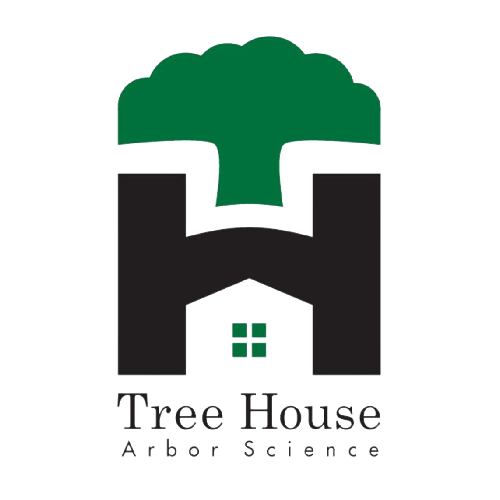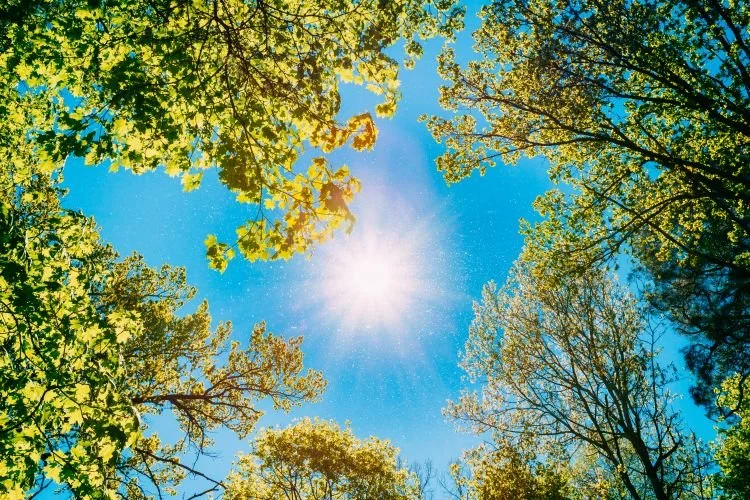Summer Heat Can Damage Wisconsin Trees
How does summer heat affect my trees in Madison?
Don’t let a summer heat wave stress your trees.
Summer heat can significantly stress trees in Madison, making them more vulnerable to disease, pests, and even death.
Trees dissipate heat by transpiring water from their roots, through their leaves, and into the air. While this is a natural cooling mechanism, as temperatures rise above 85F, water loss through transpiration can double. Tree roots struggle to draw enough moisture from the soil to compensate, leading to moisture stress.
Increased Vulnerability to Pests and Diseases: Heat-stressed trees are weakened, making them more susceptible to attacks from insects and diseases they might otherwise resist.
Urban Heat Island Effect: Madison, like other cities, experiences the "urban heat island effect." Pavement and buildings absorb and re-radiate heat, raising local temperatures and putting extra pressure on nearby trees.
Reduced Nutrient Uptake: During extreme temperatures, trees may close their stomata (pores on leaves) to conserve water, which can also shut down their ability to draw nutrients from the soil. Prolonged lack of nutrients and water can have severe consequences.
Are some trees affected more than others?
When selecting tree species for Madison, especially with an eye towards hot summers and potential drought, it's important to choose trees that are not only cold-hardy for the region (Madison is generally USDA Zone 5a) but also possess good heat and drought tolerance once established.
Here are some tree species commonly recommended for their resistance to hot summers and drought in the Madison area, often including native options:
This hearty Hackberry is a good choice for Madison yards.
Large Shade Trees (40+ feet tall):
Bur Oak (Quercus macrocarpa): A true workhorse, very cold-tolerant, well-adapted to hot summers, and long-lived once established. It's also tolerant of various soil conditions.
Kentucky Coffeetree (Gymnocladus dioica): A tough, adaptable species known for its drought and pollution tolerance. It has a unique, coarse texture in winter.
Hackberry (Celtis occidentalis): Often overlooked but highly resilient, hackberry tolerates a variety of soils and is very cold-hardy.
Northern Red Oak (Quercus rubra): A fast-growing oak that makes a beautiful shade tree for larger lawns.
Shumard Oak (Quercus shumardii): A strong, long-lived tree with good fall color and adaptability.
London Planetree (Platanus x acerifolia): While not native, it's very tough and tolerant of urban conditions, including heat and pollution, with a deep root system.
Northern Catalpa (Catalpa speciosa): Known for its large leaves and showy white flowers, it's a drought-tolerant native that can handle hot conditions.
Ginkgo (Ginkgo biloba): An ancient and very tough tree with unique fan-shaped leaves that turn brilliant yellow in fall. Choose male cultivars to avoid the messy fruit. Extremely durable once established.
Medium to Small Trees (up to 40 feet tall):
Serviceberry (Amelanchier spp.): A beautiful four-season tree/shrub with spring flowers, edible berries, and good fall color. Many varieties are quite adaptable.
Eastern Redbud (Cercis canadensis): Known for its stunning pink-purple flowers in early spring, this native is reasonably heat-tolerant once established.
Eastern Redcedar (Juniperus virginiana): Despite its name, this is a juniper, and it's an incredibly adaptable evergreen that can grow in a wide range of conditions, including dry, hot areas.
American Hornbeam (Carpinus caroliniana): A slow-growing, attractive tree with interesting bark and good fall color. It's generally free of serious pest or disease issues.
River Birch (Betula nigra): While it prefers moist soils, 'River Birch' is more heat-tolerant than other birches and offers attractive peeling bark. Look for improved cultivars like 'Heritage' for better performance.
Ironwood (Ostrya virginiana): A smaller, slow-growing native tree, also known as American Hophornbeam, that is very tough and adaptable, suitable for dry sites.
Important Considerations for Madison and Dane County
Native vs. Adapted: While native trees are often a good choice as they are naturally suited to the climate, many non-native species are also well-adapted and perform beautifully.
Soil Type: Madison has a variety of soil types. While many of these trees are adaptable, knowing your specific soil (clay, loam, sand) can help you fine-tune your selection.
Establishment: Even drought-tolerant trees need consistent watering during their first 2-3 years to establish a strong root system.
Pest and Disease Resistance: Choose varieties that are known to be resistant to common pests and diseases in Wisconsin. For example, when choosing crabapples, select disease-resistant cultivars.
Diversity: To create a resilient landscape, avoid monocultures. Plant a variety of species to reduce the risk of a single pest or disease wiping out all your trees.
Before making a final decision, it's always a good idea to consult with local nurseries or the UW-Madison Extension for the most current recommendations specific to your site conditions.
How hot does it have to get to start hurting my trees?
The optimal growing temperature range for trees in Madison and Dane County is between 59F and 86F.
When temperatures consistently rise above 90F and linger for several days, trees will begin to show signs of heat stress. At these temperatures, their growth can slow, and they struggle to perform photosynthesis efficiently. Water loss through transpiration increases significantly.
Above 104F, symptoms of heat stress become more pronounced and can lead to irreversible damage, especially if prolonged. At these extreme temperatures, trees may close their stomata (pores on leaves) to conserve water, which unfortunately also shuts down photosynthesis and nutrient uptake.
Irreversible damage can occur around 120-130F, and temperatures consistently above 115F can be lethal to tree tissues. It's important to remember that leaf temperatures in direct sunlight can be 10 degrees or more higher than the ambient air temperature.
Factors that Intensify Heat Stress in Madison:
This young Ginkgo needs more water than it’s older, larger cousins to withstand a heat wave.
Duration of Heat: A single day above 90F might not be devastating, but a multi-day heatwave (several days of abnormally hot weather) will significantly stress trees.
Drought Conditions: The most critical factor alongside high temperatures is the lack of water. If a heatwave occurs during a dry spell, trees are much more vulnerable because they can't access enough moisture to cool themselves through transpiration.
Tree Health and Age: Newly planted trees, young trees, and older, established trees are generally more susceptible to heat stress. Trees that are already weakened by pests, diseases, or previous stresses will also suffer more.
In Madison, while average summer daily high temperatures are around 79F, they can occasionally exceed 90F, especially in July. When these higher temperatures combine with dry periods, it's crucial to actively monitor and water your trees to prevent significant stress and potential long-term damage.
How can I tell if a tree has been damaged by the heat?
Symptoms of Heat Stress:
Leaf scorch: Leaves turn brown or crispy, often starting at the edges.
Curled or wilted leaves: Leaves may droop or curl to reduce surface area and minimize water loss.
Early fall coloration: Leaves may change color and drop prematurely.
Defoliation: Significant leaf loss.
Twig dieback: Branches or twigs start to die.
Stunted growth: Overall reduced growth and smaller leaves.
Bark cracks: In extreme cases, the bark may crack.
Is there anything I can do to protect my trees from the heat?
Watering is crucial. Water deeply and slowly to encourage strong root growth. Soaker hoses or trickle irrigation are highly effective, allowing water to penetrate deep into the root zone.
Frequency:
Newly planted trees (1-3 years old): Require more frequent watering. Daily for the first 1-2 weeks, then every 2-3 days for the next 10 weeks, and then weekly until established (which can take 3-5 years or more, depending on tree size). Aim for 10 gallons of water per inch of trunk diameter.
Established trees: Need a good soaking once a week, especially if rainfall is inadequate. Heavy soil needs about 1 inch of water per week, while sandy soil may need 1.5 inches.
Timing: Water early in the morning or late in the day to minimize water loss due to evaporation. Avoid watering from above to prevent foliar diseases.
Check Soil Moisture: Don't assume rainfall is enough. Poke a finger an inch deep into the soil to check for dryness.
Mulch:
Apply a 2-4 inch layer of organic mulch (wood chips, bark, compost) around the tree's drip line. Mulch helps conserve soil moisture, keeps roots cool, and reduces weed competition.
Important: Keep mulch at least 2-6 inches away from the tree trunk to prevent rot and stem-girdling roots. Avoid "mulch volcanoes."
Avoid Summer Pruning: Pruning during hot and dry periods adds stress to the tree. Wait until fall or winter for major pruning.
Avoid Fertilizing: Do not fertilize trees during hot and dry periods. Fertilizers can dehydrate plants and burn feeder roots. Wait until fall.
Plant the Right Trees: When planting new trees, choose species that are well-suited to Madison's climate and consider their mature size and sun/wind exposure. Strategic placement can help them thrive.
Monitor for Pests and Diseases: Regularly inspect your trees for signs of stress, pests, or disease, and address any issues promptly.
If you are concerned that your trees have been or may be damaged by heat, contact us for a free consultation. Our trained arborists will help you identify weak or vulnerable trees, suggest treatment, and help you choose and plant trees that are most suitable for your soil, location, and landscape.



